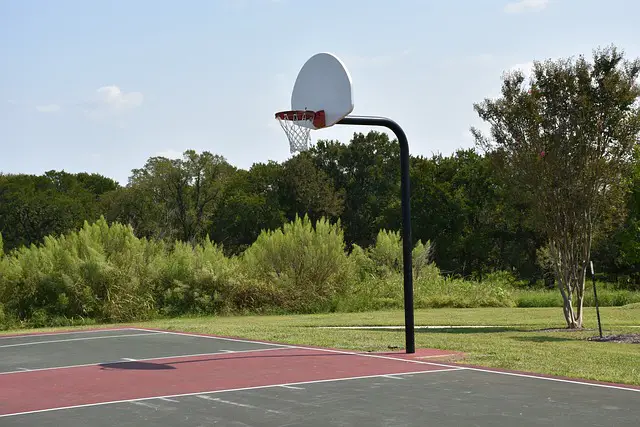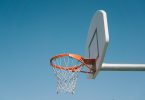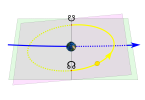If you’re a basketball fan, you know that the game is divided into two main areas: the front court and the back court. The front court is the area between the baseline and the free-throw line, and it’s where most of the action happens. This is where players battle for rebounds, set screens, and try to score points.
Front court basketball is all about strategy and teamwork. It requires players to work together to create opportunities for themselves and their teammates. It’s not just about scoring points; it’s about controlling the game and dictating the pace. If you want to be successful in the front court, you need to be agile, quick-thinking, and able to read the game. Whether you’re a center, a power forward, or a small forward, you need to be able to adapt to different situations and make split-second decisions.
Understanding Front Court
In basketball, the front court refers to the area of the court that is closer to the opponent’s basket. This area is where most of the offensive plays are initiated, and where the majority of the scoring occurs. Understanding the front court is essential for any basketball player or fan who wants to have a comprehensive understanding of the game.
One of the key features of the front court is the presence of the key or paint. This area is a rectangular box located directly in front of the basket and is used for a variety of offensive and defensive purposes. Offensive players will often try to get into the key to create scoring opportunities, while defensive players will try to prevent them from doing so.
Another important feature of the front court is the presence of the three-point line. This line is located 22 feet away from the basket and is used to determine whether a shot is worth two or three points. In basketball, shots attempted from beyond the three-point line are worth three points, whereas shots attempted from inside the line are worth two points.
The front court is also where the majority of the rebounding occurs. Offensive players will try to grab missed shots in order to get a second chance at scoring, while defensive players will try to prevent them from doing so. Rebounding is an essential skill for any basketball player, as it allows them to control the flow of the game and create scoring opportunities for themselves and their teammates.
Overall, understanding the front court is essential for any basketball player or fan who wants to have a comprehensive understanding of the game. By familiarizing yourself with the key, the three-point line, and the importance of rebounding, you can develop a deeper appreciation for the nuances of the game and become a more knowledgeable and effective player.
Roles in Front Court
Point Guard
As the primary ball-handler, the point guard is responsible for initiating the team’s offense and setting up plays. They must have excellent ball-handling skills, be able to make quick decisions, and have good court vision. Point guards are typically smaller and quicker than other players on the court.
Shooting Guard
The shooting guard is responsible for scoring points and is usually the team’s best perimeter shooter. They must be able to shoot accurately from long range, move without the ball, and create their own shot. Shooting guards are often the second-best ball-handler on the team and must be able to play both on and off the ball.
Small Forward
Small forwards are versatile players who can play multiple positions. They are typically taller than shooting guards and have a good combination of size, speed, and athleticism. Small forwards must be able to score from mid-range, drive to the basket, and defend multiple positions.
Power Forward
Power forwards play a physical game and are responsible for rebounding, defending the post, and scoring inside. They are typically bigger and stronger than small forwards and must be able to play with their back to the basket. Power forwards must also be able to shoot from mid-range and occasionally from beyond the arc.
Center
The center is the tallest player on the team and is responsible for defending the paint, rebounding, and scoring inside. They must have good footwork, be able to finish at the rim, and have good post moves. Centers are typically slower than other players on the court but make up for it with their size and strength.
Overall, each position in the front court plays a crucial role in the team’s success. By understanding the responsibilities of each position, you can better appreciate the skills and contributions of each player on the court.
Offensive Strategies
Pick and Roll
When running a pick and roll play, you want to create space for your ball handler to drive to the basket or create a passing lane to the roll man. The pick should be set at the right angle and timing to make it difficult for the defender to switch or recover. It’s important that the ball handler reads the defense and makes the right decision – either attacking the basket or passing to the open man.
Fast Break
In a fast break situation, you want to push the ball up the court as quickly as possible to catch the defense off guard. The key to a successful fast break is spacing and communication. Players need to run to their designated spots on the court and communicate with each other to avoid turnovers and missed opportunities. It’s also important to have a player who can finish at the rim or shoot from outside.
Isolation Plays
Isolation plays are designed to give your best player a chance to score one-on-one against their defender. The key to a successful isolation play is spacing and timing. You want to create enough space for your player to operate and give them enough time to make a move. It’s also important to have options for your player if the defense collapses, such as a kick out to a shooter or a cut to the basket.
Overall, the key to a successful offense is to have a variety of strategies that can be used in different situations. By utilizing pick and roll plays, fast breaks, and isolation plays, you can keep the defense guessing and create scoring opportunities for your team.
Defensive Strategies
When it comes to defending the front court, there are several strategies that teams can employ. Each strategy has its own strengths and weaknesses, and the key is to find the one that works best for your team. In this section, we’ll take a closer look at three of the most common defensive strategies: man-to-man defense, zone defense, and press defense.
Man-to-Man Defense
Man-to-man defense is a prevalent defensive tactic in basketball, where each defensive player is responsible for guarding a specific offensive player. The primary objective is to prevent the offensive player from scoring or passing the ball to their teammates.
One advantage of man-to-man defense is that it allows for more aggressive play. Defenders can get up close and personal with their assigned player, making it harder for them to get open and make plays. However, man-to-man defense can also be more physically demanding, as defenders have to constantly move and adjust to their opponent’s movements.
Zone Defense
Zone defense is another popular strategy. With this strategy, defenders are assigned to specific areas of the court rather than specific players. The goal is to clog up passing lanes and prevent the offense from getting easy shots.
One advantage of zone defense is that it can be easier to execute than man-to-man defense. Defenders don’t have to worry about getting beat by their assigned player, and can focus more on playing the passing lanes and disrupting the offense. However, zone defense can also be more vulnerable to outside shooting, as defenders may not be able to close out on shooters as quickly.
Press Defense
Press defense is a more aggressive strategy that involves putting pressure on the offense as soon as they inbound the ball. With this strategy, defenders try to force turnovers and create fast break opportunities.
One advantage of press defense is that it can be very effective at disrupting the offense and creating turnovers. However, it can also be very physically demanding and requires a lot of energy from the defenders. Additionally, if the press is broken, it can leave the defense vulnerable to easy scoring opportunities.
In conclusion, there are several different defensive strategies that teams can use when defending the front court. Each strategy has its own strengths and weaknesses, and the key is to find the one that works best for your team. Whether you choose man-to-man defense, zone defense, or press defense, the most important thing is to communicate and work together as a team to shut down the opposing offense.
Importance of Rebounding
One of the most critical aspects of front court basketball is rebounding, which can often determine the outcome of a close game. Rebounding involves gaining possession of the ball after a missed shot.
Offensive Rebounding
In basketball, offensive rebounding refers to the action of gaining possession of the ball after your team has missed a shot. Offensive rebounds can offer a second opportunity to score and help retain possession of the ball. To achieve offensive rebounds, players need to combine skill, timing, and effort.
When you are attempting to grab an offensive rebound, it is important to position yourself in a way that allows you to get the best possible angle to the ball. This often means boxing out your defender and positioning yourself in a way that allows you to jump higher than your opponent.
Defensive Rebounding
In basketball, defensive rebounding involves gaining possession of the ball after your opponent has missed a shot. Defensive rebounds are vital as they prevent your opponent from scoring second-chance points and help your team retain possession of the ball.
When you are attempting to grab a defensive rebound, it is important to box out your opponent and position yourself in a way that allows you to get the best possible angle to the ball. It is also important to be aware of where your opponents are on the court and to communicate with your teammates to ensure that everyone is in the right position to grab the rebound.
Front Court Skills
Shooting
When it comes to front court basketball, shooting is a crucial skill to have. You need to be able to put the ball in the hoop from various positions on the court. To improve your shooting, focus on your form and technique. Make sure your feet are positioned correctly, your elbow is in, and your follow-through is consistent. Practice shooting from different spots on the court, including the mid-range and beyond the arc.
Passing
Passing is another important skill for front court players. You need to be able to make accurate passes to your teammates, especially when the defense is tight. Work on your passing accuracy and speed by practicing different types of passes, such as chest passes, bounce passes, and overhead passes. Learn to read the defense and anticipate where your teammates will be on the court.
Dribbling
Dribbling is essential for front court players, as it allows you to move the ball up the court and create scoring opportunities. Practice dribbling with both hands and work on your ball-handling skills. Learn different dribbling moves, such as crossovers and spin moves, to keep the defense guessing.
Rebounding
Rebounding is all about positioning and timing. You need to be able to read the trajectory of the ball and position yourself accordingly. Work on your jumping ability and timing to improve your rebounding skills. Practice boxing out and learn to anticipate where the ball will come off the rim.
Blocking
Blocking is a defensive skill that can help you disrupt your opponent’s shots and create turnovers. To improve your blocking skills, work on your timing and footwork. Learn to read your opponent’s movements and anticipate their shots. Practice jumping and swatting the ball without fouling.
Remember, front court basketball requires a combination of skills, including shooting, passing, dribbling, rebounding, and blocking. Focus on improving your skills in each of these areas to become a well-rounded front court player.
Famous Front Court Players
When it comes to front court basketball, there have been many legendary players throughout history. Here are some of the most famous front court players of all time:
1. Wilt Chamberlain You can’t talk about front court basketball without mentioning Wilt Chamberlain. He was a dominant force on the court, known for his incredible scoring ability and rebounding skills. He won two NBA championships and was a four-time MVP.
2. Bill Russell Another legendary player, Bill Russell was a key member of the Boston Celtics during the 1950s and 1960s. He won an incredible 11 NBA championships and was a five-time MVP. Russell was known for his defensive skills and shot-blocking ability.
3. Kareem Abdul-Jabbar Kareem Abdul-Jabbar holds the record for being the NBA’s all-time leading scorer, and it’s no surprise why. He was an unstoppable force on the court, renowned for his skyhook shot and ability to score from any position. Abdul-Jabbar won six NBA championships and was named MVP six times.
4. Tim Duncan Tim Duncan was a consistent force in the front court for the San Antonio Spurs for nearly two decades. He won five NBA championships and was a three-time Finals MVP. Duncan was known for his fundamentally sound play and his ability to dominate on both ends of the court.
5. Shaquille O’Neal Shaquille O’Neal was a dominant force in the front court during his playing days. He won four NBA championships and was a three-time Finals MVP. Known for his size and strength, O’Neal was nearly unstoppable in the paint.
These players are just a few examples of the many great front court players in basketball history. Their skills and accomplishments have helped shape the game into what it is today.







